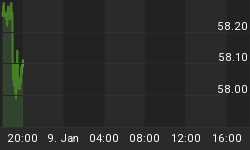As we entered September we looked at the historical and seasonal tendencies of the XAU gold/silver index for the month of September and concluded that September tends to be positive for the XAU and since 1994 has only been a down month when the XAU entered the month in an interim downtrend (one that usually began in the month of June).
Moreover, we found that when the XAU enters September in a rising trend, and especially if the dominant interim 30/60/90-day moving averages are all up, the month tends to be a positive one overall. This useful characterization of the XAU's historical September trends provided a useful guide through the halfway point of the month, as the XAU has been in an impressive upside run every since.
Now that we've passed the month's halfway point, what is the market telling us to expect for the XAU in the immediate-term? Has the XAU overshot its mark with this rally? Has XAU gone "parabolic" and therefore in danger of collapsing? Or are the main trends and seasonal tendencies still intact for a continued uptrend as we head into the fourth quarter? We'll turn to the market for answers to these questions in this second installment of the article entitled, "The XAU in September."
First, to allay fears that the XAU has gone parabolic and is in danger of collapsing, I don't believe this to be the case. We're still in the most historically positive seasons of the year for the gold shares, which I like to call "rally season." These bullish seasonal tendencies will likely help keep the sector buoyant through the corrective pullbacks and rough spots that may be encountered along the way as we head further into the fourth quarter. The market has responded well to the numerous positive reports from the various gold and silver mines as more companies release findings and results. And as we'll see, the waves of upward momentum that the sector has built up over recent months appear to be strong enough to carry it through the weak spots between now and the end of "rally season." But since reversals can occur, a judicious use of protective stops is always in order whenever trades are made in the gold stock sector.
Interim considerations aside, what about the immediate-term? After the XAU's vigorous rally this month to date, the indicators have hit "overbought" readings across the board, which increases the likelihood of a correction. The XAU's leading indicator, Freeport Gold (FCX), has lagged behind so far this month in the across-the-board rally. And the XAU has also pulled a bit too far away from its underlying 200-day moving average. This evidence suggests a correction is in order, near term.

One useful way of discerning overbought or oversold market conditions for the gold stock sector is what is known as the 50-day MA Indicator. Each Friday we go through the a listing of 42 actively traded gold stocks which compose a cross-section of seniors, mid-tiers and juniors. After examining the list on a stock-by-stock basis to determine the number of components above or below their respective 50-day (10-week) moving averages, we can then make useful decisions for gauging "overbought" or "oversold" market conditions. When an increasing number of gold stocks are below their 50-day MAs, the market is usually ripe for an oversold rally. Conversely, whenever too many of the gold shares get above their 50-day MAs the market is usually ripe for a "correction" or pullback. We update this indicator every Friday in the Durban Deep Report.
Here are the gold shares of our 42-stock listing below their respective 50-day moving averages as of Friday's (Sept. 16) close: Coral Gold, Crystallex, Metallic Ventures, Northgate Exploration, and Randgold & Exploration Co. That's a mere five stocks out of 42 below the 50-day MA, a recent low. This suggests the gold stock rally is "overbought" in the immediate-term and therefore ripe for a corrective pullback in the days ahead.
Here is how the 50-day MA indicator looks for the past four weeks for the purpose of comparison:
8/26 - Eleven (11)
9/2 - Eighteen (18)
9/9 - Eleven (11)
9/16 - Five (5)
You'll notice that the week ending September 2 saw the highest number of gold stocks below their respective 50-day moving averages in quite a while. This extreme "oversold" position the market was in helped give rise to the impressive rally we've seen unfold since that time. With the number of golds below their 50-day MAs shrinking, however, caution is definitely warranted in the immediate-term until we see another expansion in the 50-day MA indicator.

Above you'll see a graphic depiction of the XAU's 5-day, 10-day and 20-day rate of change oscillators. These oscillators are all well above the "zero" line, which is positive. Yet the 10-day and 20-day oscillators are hitting overbought extremes in the immediate-term. But the overriding message of this indicator is that the momentum the XAU has built up over the past several weeks will likely see it through the next corrective phase.















